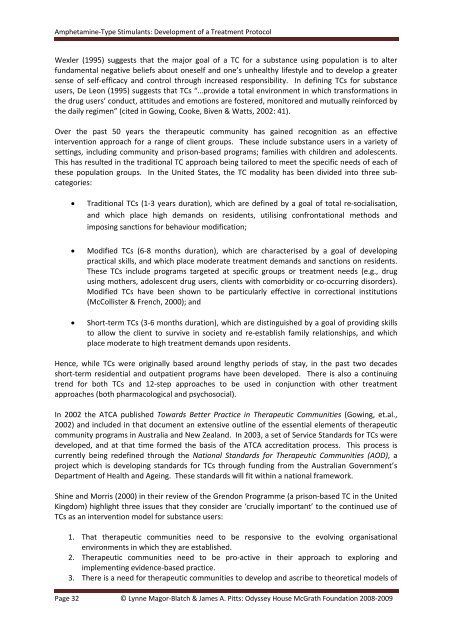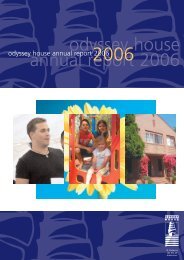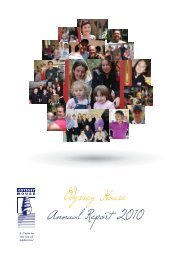ATS Literature Review, Consultations & Trial - Odyssey House
ATS Literature Review, Consultations & Trial - Odyssey House
ATS Literature Review, Consultations & Trial - Odyssey House
You also want an ePaper? Increase the reach of your titles
YUMPU automatically turns print PDFs into web optimized ePapers that Google loves.
Amphetamine‐Type Stimulants: Development of a Treatment Protocol<br />
Wexler (1995) suggests that the major goal of a TC for a substance using population is to alter<br />
fundamental negative beliefs about oneself and one’s unhealthy lifestyle and to develop a greater<br />
sense of self‐efficacy and control through increased responsibility. In defining TCs for substance<br />
users, De Leon (1995) suggests that TCs “…provide a total environment in which transformations in<br />
the drug users’ conduct, attitudes and emotions are fostered, monitored and mutually reinforced by<br />
the daily regimen” (cited in Gowing, Cooke, Biven & Watts, 2002: 41).<br />
Over the past 50 years the therapeutic community has gained recognition as an effective<br />
intervention approach for a range of client groups. These include substance users in a variety of<br />
settings, including community and prison‐based programs; families with children and adolescents.<br />
This has resulted in the traditional TC approach being tailored to meet the specific needs of each of<br />
these population groups. In the United States, the TC modality has been divided into three sub‐<br />
categories:<br />
• Traditional TCs (1‐3 years duration), which are defined by a goal of total re‐socialisation,<br />
and which place high demands on residents, utilising confrontational methods and<br />
imposing sanctions for behaviour modification;<br />
• Modified TCs (6‐8 months duration), which are characterised by a goal of developing<br />
practical skills, and which place moderate treatment demands and sanctions on residents.<br />
These TCs include programs targeted at specific groups or treatment needs (e.g., drug<br />
using mothers, adolescent drug users, clients with comorbidity or co‐occurring disorders).<br />
Modified TCs have been shown to be particularly effective in correctional institutions<br />
(McCollister & French, 2000); and<br />
• Short‐term TCs (3‐6 months duration), which are distinguished by a goal of providing skills<br />
to allow the client to survive in society and re‐establish family relationships, and which<br />
place moderate to high treatment demands upon residents.<br />
Hence, while TCs were originally based around lengthy periods of stay, in the past two decades<br />
short‐term residential and outpatient programs have been developed. There is also a continuing<br />
trend for both TCs and 12‐step approaches to be used in conjunction with other treatment<br />
approaches (both pharmacological and psychosocial).<br />
In 2002 the ATCA published Towards Better Practice in Therapeutic Communities (Gowing, et.al.,<br />
2002) and included in that document an extensive outline of the essential elements of therapeutic<br />
community programs in Australia and New Zealand. In 2003, a set of Service Standards for TCs were<br />
developed, and at that time formed the basis of the ATCA accreditation process. This process is<br />
currently being redefined through the National Standards for Therapeutic Communities (AOD), a<br />
project which is developing standards for TCs through funding from the Australian Government’s<br />
Department of Health and Ageing. These standards will fit within a national framework.<br />
Shine and Morris (2000) in their review of the Grendon Programme (a prison‐based TC in the United<br />
Kingdom) highlight three issues that they consider are ‘crucially important’ to the continued use of<br />
TCs as an intervention model for substance users:<br />
1. That therapeutic communities need to be responsive to the evolving organisational<br />
environments in which they are established.<br />
2. Therapeutic communities need to be pro‐active in their approach to exploring and<br />
implementing evidence‐based practice.<br />
3. There is a need for therapeutic communities to develop and ascribe to theoretical models of<br />
Page 32 © Lynne Magor‐Blatch & James A. Pitts: <strong>Odyssey</strong> <strong>House</strong> McGrath Foundation 2008‐2009








